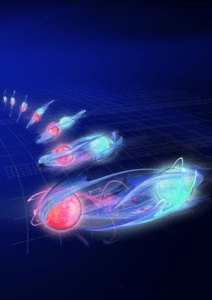Summary
To address questions in modern physics such as “what is the structure of matter inside neutron stars?” we need better computational methods to evaluate the interplay of fundamental forces between elementary particles. To-date the response to such questions rests on numerical computer simulations that are inherently limited. In this project, we develop new theoretical tools for quantum simulations of non-Abelian problems in high energy physics (HEP), and HEP problems beyond one dimension. Our work is conducted in close collaboration with experimental groups to design robust and feasible simulation schemes that are custom-designed to particular quantum platforms. We will integrate methods from machine learning and artificial intelligence to create a conceptually new framework for hybrid quantum-classical simulations. These novel tools are expected to find useful applications beyond HEP in material science and chemistry. Through collaborations with Creative Destruction Lab and the Vector Institute we plan to accelerate the path to industry deployment.
Related Content

Micro-Supercapacitors Based on Termination Optimized MXene Quantum Dots with Ultra-High Rate Capability and Fast Frequency Response
Micro-supercapacitors (MCs) are miniaturized energy storage devices that can enhance the performance of wearable health devices, medical implants, wireless sensors, and micro-electromechanical systems due to their fast frequency response, long life cycle, and vast temperature operation. However, to make these MC systems into commercially feasible products, necessary improvements to current MC performance are necessary, primarily […]
June 12, 2023
Novel Superconducting Qubits for Error-Corrected Processors
Summary In this project, we develop novel superconducting qubits for error-corrected processors to enable large-scale quantum computing. Our design efforts will specifically target error-corrected architectures through a variety of paths. Possible features will include built-in parity measurements and the use of bosonic codes, such as Fock state and Cat codes, as our starting focus. Early […]
June 26, 2019
Implementing High-fidelity Quantum Gates in Multi-level Trapped Ions
Summary The scalability of quantum processors is limited by current error rates for single-qubit gates. By encoding more than a single bit of information within a single ion, multi-level “qudits” offer a promising method of increasing the information density within a quantum processor, and therefore minimizing the number of gates and associated error rates. […]
July 30, 2018

Harnessing the Promise of Quantum Materials for Future Electronic Devices
Summary Two-dimensional (2D) quantum materials, such as graphene and molybdenum disulfide, have great potential for use in future flexible and wearable electronics applications. With traditional silicon-based electronics nearing their theoretical performance limits, nano-electronics made from 2D quantum materials offer breakthrough opportunities for energy-efficient, wearable ubiquitous computation. In this project, we will study integration of […]
June 14, 2018


